How To Cook Seafood
A tutorial on cooking your favorite seafoods in the oven, on the stove top, or on the grill
You have a cut of beautiful, wild-caught seafood in your freezer and you’re ready to cook: so what do you do? Have no fear! We have extensive experience cooking salmon and high-quality, wild seafood. We swear: cooking seafood to restaurant-level-perfection is much easier than you may think. Here are some tips from our kitchen, to yours. Once you’ve got the basics down, go check out our recipes page to really spice things up! Good luck and bon appétit!
Thawing
The best way to preserve optimal flavor and texture in seafood is to thaw overnight in the refrigerator. Place the wrapped package on a plate and allow 8-10 hours (large cuts may take a bit longer) to thaw. Try to avoid speeding up the process of thawing by defrosting it in the microwave or thawing under warm water. Doing this may cause salmon and other seafood to lose flavor and texture. If time is a factor, with a little attention to detail, you can certainly always cook your salmon frozen (check out “Cook It Frozen” techniques from cookitfrozen.com)

Grilling
Preparing the Grill
- Most fish cooks best over a medium-high flame
- Ensure the grill is hot before you start cooking
- Liberally brush oil onto the grill or cooking surface just prior to cooking
Grilling Seafood
- Oil lightly and season fish to desired amount just before cooking
- Grill skin-on seafood cuts skin side down for best results. Skinless and more delicate fillet often cook best in a foil or parchment-line foil pouch. Mix in your favorite grilling veggies and herbs for quick and easy prep.
- Cook fish approximately 10 minutes per inch of thickness
- Seafood continues to cook after it’s removed from the heat, so take it off just as soon as it starts to flake. We often tell our customers that if they think their fish is almost done cooking-- it’s done!
- Slide a sharp knife tip into the center of the thickest part of a cooking salmon portion, checking for color and an internal temperature of at least 145°F. Our favorite is when colorful fish such as salmon and tuna is still red/rare on the inside). We have found that overcooking is one of the biggest mistakes our customers make. This is quality seafood, no need to dry it out!

Plank Grilling
Planking is a traditional Northwest-style of cooking using aromatic pieces of wood. It’s a great way to add subtle flavor to your wild Alaska Seafood while also offering an impressive serving platter. Grilling planks can be found at Wild For Salmon, or through many cooking and housewares stores across the country.
- The best wood choices for planking are Cedar, Alder and Oak
- Pre soak the plank in water for at least 30 minutes and up to overnight in a clean sink
- Pat planks dry and spray-coat or lightly oil one side, place cut on plank skin-side down
- Season seafood lightly with an herb blend, or just salt and pepper. Go easy, as you don’t want to overpower the light flavor obtained from the plank
- Preheat the grill to medium-high
- Place your planked seafood on the grill over indirect heat and close the lid
- Turn the heat down to medium
- Check salmon frequently after 10 minutes
- Seafood continues to cook after it is removed from the heat, so refer to our grilling tips above to learn how to tell when salmon and seafood portions are finished cooking
- Serve: the plank provides a beautiful, organic-looking platter for serving
Baking
- Rinse and pat fillets dry
- Spread a thin coat of oil over salmon or seafood portion
- Coat bottom of oven-safe pan with oil
- Sprinkle seasonings over fish
- Bake in 375°F oven for 10-12 minutes per inch of thickness or until fish just begins to flake at the edges
Broiling
- Preheat the broiler to Med/High
- Rinse and pat fillets dry
- Place parchment paper inside a shallow, nonmetal dish and seafood portion on top of parchment, skin side down.
- Top with cooking oil and seasonings of choice
- Broil the fish 4 to 6" from the heating element for 5 to 6 min or until fish is done (no need to turn or flip).
Poaching
- Place poaching liquid in saucepan
- Bring to boil and reduce to simmer
- Place seafood in liquid, cover with a lid and poach for 8 to 10 minutes, depending on thickness (8 minutes per inch thick) or until seafood is to an internal temperature of 145°F
 Sockeye Salmon Ravioli
Sockeye Salmon Ravioli
Bring 6 quarts of water to a rolling boil. Submerge frozen ravioli in boiling water. Bring water back to a gentle boil, cook for 4 to 5 minutes. Avoid stirring aggressively as it can break apart this handmade ravioli, causing the delicious filling to boil out. Simply top with just olive oil and parmesan, creamy dill sauce, or a light tomato sauce.
Alternatively, thaw and sauté! With just a little butter, onion and garlic, sautéed salmon ravioli makes a fantastic and quick treat. Top sautéed ravioli with your favorite sauce or enjoy plain!




 Wild Alaska Salmon
Wild Alaska Salmon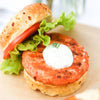 Alaska Salmon Burgers
Alaska Salmon Burgers Smoked Salmon & Seafood
Smoked Salmon & Seafood Wild Alaska Whitefish
Wild Alaska Whitefish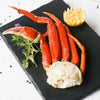 Wild Shellfish & Shrimp
Wild Shellfish & Shrimp Wild Albacore Tuna
Wild Albacore Tuna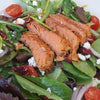 Canned Seafood
Canned Seafood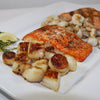 Meal Box & Samplers
Meal Box & Samplers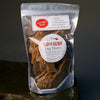 Pet Products
Pet Products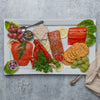 Gifts
Gifts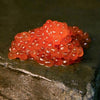 Specialty
Specialty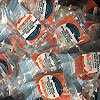 Wholesale Ordering
Wholesale Ordering
 Sockeye Salmon Ravioli
Sockeye Salmon Ravioli